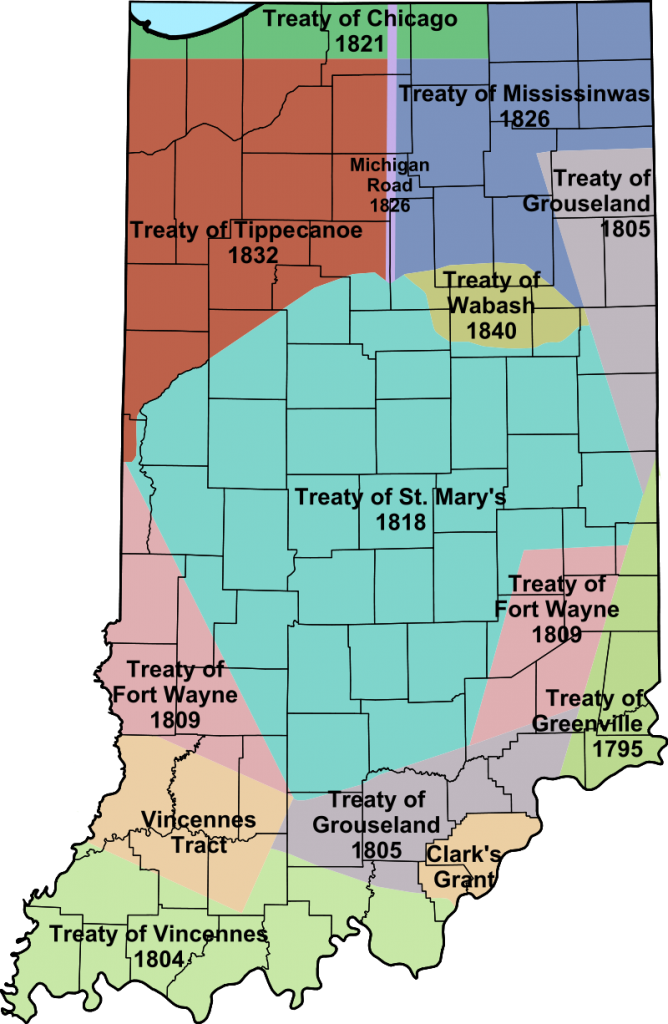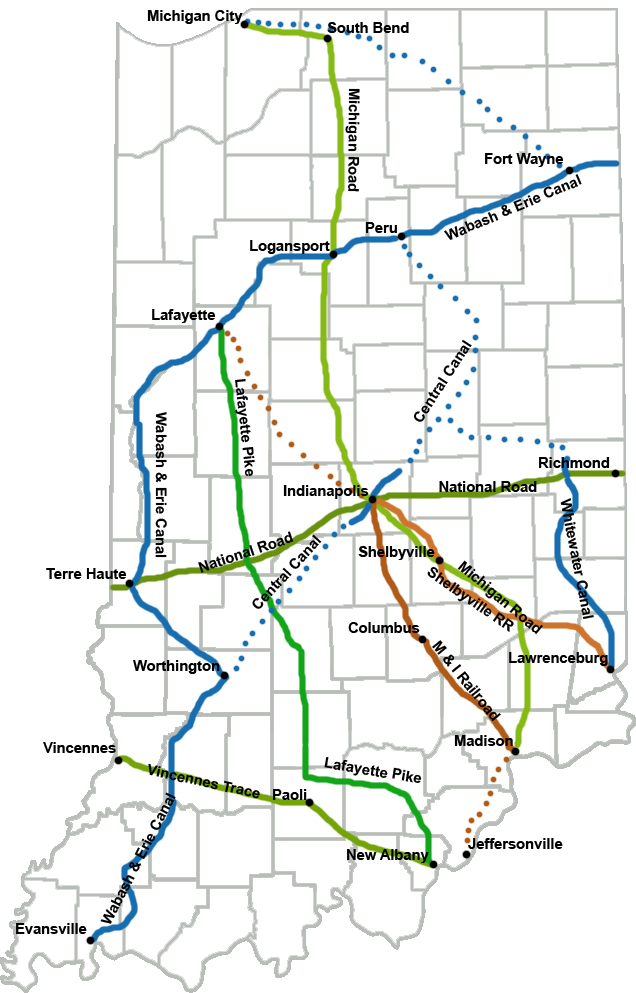This is installment 3.5 of my Indiana Bicentennial series. Installment 3 covers generally the period from 1832 to 1848. 3.1: national context; 3.2: Gov. Noah Noble; 3.3: Indiana’s Mammoth Internal Improvement Act of 1836; and 3.4: Governor Wallace and Indian removal in Indiana. This short installment will look at Gov. Samuel Bigger.
Samuel Bigger (1840 – 1843)
By 1840, the disastrous financial consequences of the Panic of 1837 and the Internal Improvement financing was being fully felt in Indiana. The Whigs decided not to nominate Wallace, their sitting governor, and instead nominated Samuel Bigger who had no connection to the Mammoth Internal Improvement Act. The Democratic nominee, Tilghman Howard, had been in the General Assembly at the time of the Act and had voted for it. Bigger claimed to never have supported the Internal Improvement Act. (Given its general popularity at the time, this seems at least somewhat dubious.) Bigger was also aided by the fact that William Henry Harrison was on the ballot as the Whig Presidential candidate. Harrison’s reputation in the state had improved with the rose-colored glasses of hindsight, and he had become something of a folk hero. Despite the state’s financial struggles, the Whigs retained majorities in the legislature, and Bigger defeated Tilghman.
Bigger’s honeymoon didn’t last long. the State’s payment on its debt was double its revenues. The state soon defaulted on payments and, in an effort to come to grips with the situation, the State imposed a massive tax increase (apparently up to a 300% increase in some places). Efforts were made to complete the improvements, the Wabash & Erie in particular, in order to capture revenues from the improvements. However, those efforts did not make a sufficient dent in the debt.
In 1841, Bigger — a lawyer and former circuit court judge — rewrote Indiana’s code of laws with the assistance of state treasurer George Dunn. This was apparently the Indiana Code’s first major reorganization since 1824, and I believe the system for updating it from year-to-year as the General Assembly amends it dates from the 1841 reorganization.
Bigger’s re-election prospects, likely challenging under the circumstances in any event, were not helped by the surfacing of anti-Methodist quotes Bigger had made some years earlier when he was in the legislature. Early Methodist thought in the state had been cool on the idea of higher education. The denomination had reconsidered that position but, by the 1830s, Presbyterians dominated higher education in Indiana. Presbyterians controlled the Board of Trustees and faculty at Indiana College in Bloomington. They had also founded Hanover and Wabash. Methodists, having concluded that higher education was necessary to retain young people and advance their church, were trying to gain representation in Bloomington. Methodists outnumbering Presbyterians in the state on the order of 4-to-1, their strategy in 1834 was to attempt to have the legislature select the university board. At the time of that debate, Bigger – a Presbyterian – was a lawyer and a representative from Rushville. He vocally doubted the ability of American Methodists to manage a “literary institution,” claiming that when his alma mater of Ohio University wanted a Methodist professor, they had to send to Europe to acquire one. Bigger said there was “not a Methodist in America with sufficient learning to fill a professor’s chair.” When he ran for re-election in 1843, this came back to bite him.
Methodists, in particular a professor by the name of Matthew Simpson, were chafing over favorable financial treatment by the legislature for Presbyterian Wabash College. Additionally, a Presbyterian dominated convention on education was seen by the Methodists as an attempt by Presbyterians to gain control of the common schools — which, at that point, were not uniformly organized under Indiana law. Simpson dredged up the contemptuous way in which Bigger had spoken about Methodists. The Democrats, who had nominated Methodist James Whitcomb, saw an opportunity to dislodge a chunk of the normally pro-Whig Methodists in favor of the Democrats.
The Indiana State Sentinel, a Democratic paper published in Indianapolis, opened the campaign with a cleverly conceived rumor that the Whigs were attacking Whitcomb because he was a Methodist. The Lafayette Advertiser, also Democratic, confirmed the charges, adding that his being a Methodist ought to be “a recommendation instead of an objection.” “What!” exclaimed the Advertiser piously, “has it come to that, that a desperate political press shall urge it as an objection to James Whitcomb … that he is a Christian!”
Responding volleys by Whig newspapers such as the Indiana State Journal were unable to stem the tide. Given the State’s financial condition, it is difficult to say whether Bigger would have been re-elected in any case, but this campaign issue certainly did not help his cause.
I do not have a good segue for this, but it seems worth mentioning that by this point, the demographics of Indiana were changing. The early population of Indiana came along the Ohio River, mostly from Kentucky and parts south. In 1840, about 80% of the population was concentrated in the southern counties.
In 1840, the largest city in Indiana was New Albany, with 4,226 people. Indianapolis had a population of 2,692, Richmond 2,070, and Crawfordsville 1,327. Ten years later the New Albany-Jeffersonville area contained slightly over ten thousand people. The second largest city was Madison with 9,007 people, and third was Indianapolis with a population of 8,091.
As the Indians were forced out, settlers were less likely to come from the southern U.S. and more likely to come down the Wabash or up from the Ohio along the Great Miami River, Whitewater River, and even the National Road. These settlers would tend to come from points east, like Ohio and Pennsylvania. This seems to be the path taken by my family. I’m not a great genealogist, but this is generally the path the Massons seem to have taken. Mansfield B. Masson was born in Pennsylvania in 1805 and, in the 1830s was working in or around Pittsburgh. By 1847, he was in Cincinnati. His son, James P. Masson had moved to Indianapolis by the 1860s. And, even as the population was coming west, it was more common for trade to head east. With the opening of the Wabash & Erie Canal, crops would apparently go by wagon to Lafayette and then shipped up to northeastern markets such as New York and Boston. Chicago was even emerging as a market, though that was still a long wagon ride.
One account of early Chicago describes Hoosier wagons loaded with various kinds of produce which was traded for a few bags of coffee and the balance in salt; “this was the invariable return load of all Hoosiers.” The same observer claimed to have seen as many as 160 Hoosier wagons at once on the dry ground east of State Street in Chicago.
In any event, Central Indiana was starting to emerge as a vital part of the Indiana economy, and its connections to other regions of the United States was more varied than the early settlers in the southern part of the state. (Swamps and speculators seemed to have discouraged development in northern Indiana to some extent.) Before too long, sectional conflict would lead to the Civil War, and the affinity of Hoosiers with one section or another would have some relevance with respect to state and national affairs.
Next time: Gov. James Whitcomb (1843 – 1848), the Mexican-American War, and Education in Indiana

